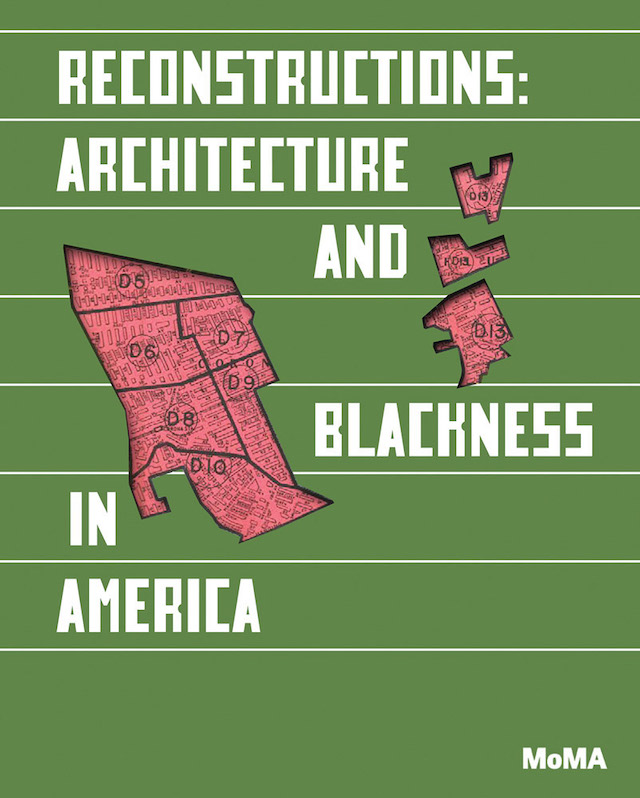Reconstructions
Reconstructions: Architecture and Blackness in AmericaSean Anderson, Mabel O. Wilson (Editors)The Museum of Modern Art, March 2021Paperback | 8 x 10 inches | 176 pages | 185 illustrations | English | ISBN: 978-1633451148 | $45.00PUBLISHER'S DESCRIPTION:Reconstructions: Architecture and Blackness in America is an urgent call for architects to accept the challenge of reconceiving and reconstructing our built environment rather than continue giving shape to buildings, infrastructure and urban plans that have, for generations, embodied and sustained anti-Black racism in the United States.The architects, designers, artists and writers who were invited to contribute to this book—and to the exhibition at the Museum of Modern Art for which it serves as a “field guide”—reimagine the legacies of race-based dispossession in 10 American cities (Atlanta; Brooklyn, New York; Kinloch, Missouri; Los Angeles; Miami; Nashville; New Orleans; Oakland; Pittsburgh; and Syracuse) and celebrate the ways individuals and communities across the country have mobilized Black cultural spaces, forms and practices as sites of imagination, liberation, resistance, care and refusal.A broad range of essays by the curators and prominent scholars from diverse fields, as well as a portfolio of new photographs by the artist David Hartt, complement this volume’s richly illustrated presentations of the architectural projects at the heart of MoMA’s groundbreaking exhibition.Sean Anderson is Associate Curator, Department of Architecture and Design, The Museum of Modern Art. Mabel O. Wilson is Nancy and George E. Rupp Professor, Graduate School of Architecture, Planning and Preservation, and Professor, Department of African American and African Diaspora Studies, Columbia University.REFERRAL LINKS: dDAB COMMENTARY:A few days after it opened on February 27th, I made my way to MoMA to see Reconstructions: Architecture and Blackness in America, the fourth in the museum's occasional "Issues in Contemporary Architecture" series. Like its predecessors, which tackled global warming (Rising Currents: Projects for New York’s Waterfront in 2010), the American housing crisis (Foreclosed: Rehousing the American Dream in 2012), and the growth of informal cities around the world (Uneven Growth: Tactical Urbanisms for Expanding Megacities in 2014), Reconstructions is a timely exhibition aligned with pressing issues. Billed as "an investigation into the intersections of architecture, Blackness and anti–Black racism in the American context," the exhibition comes one year after George Floyd and BLM, and two years after MoMA (finally) broached its own racist tendencies with the publication of Among Others: Blackness at MoMA.One of the contributors to Among Others is Mabel O. Wilson, the Columbia University professor who is also co-editor of the important Race and Modern Architecture: A Critical History from the Enlightenment to the Present and co-curator of Reconstructions, with MoMA's Sean Anderson. In "White by Design," Wilson explores the clearly discriminatory history of how the collection of the Architecture & Design Department at MoMA has been formed. Between its creation in 1932 and the publication of Among Others in 2019, only two objects by African American designers entered the collection, according to Wilson: a swatch of fabric by textile designer Joel Robinson in 1975 and a print of a collage by architect Gordon Kipping in 2000. Anything by Paul R. Williams? Nope. J. Max Bond Jr.? No, again. These and other glaring omissions can be attributed, in part, to Philip Johnson, who set up the A&D Dept. and has been called out recently for his Nazi sympathies, with calls to remove his name from titles and other honorifics at MoMA and elsewhere. The entrance to Reconstructions actually drapes a textile with a statement by the Black Reconstruction Collective over a gallery sign with Johnson's name on it.Those who can make it to MoMA before Reconstructions closes on May 31st (a short run of just three months, due no doubt to COVID-19) are strongly encouraged to do so. The eleven contributions to the show are excellent, filling the galleries with models, collages, drawings, and videos that are striking to behold. None of the pieces, though, are explicit in terms of purpose or idea; they invite closer inspection to determine what they have to say. Some of the projects are clearly architectural but most of them are provocations that spark visitors to consider the troubled histories of racism in the United States, as explored in ten urban communities selected from among the dozens of "All Black Towns" created in the short Reconstruction era after the Civil War. Those ten cities and eleven contributions comprise about half of the companion publication to the exhibition. Organized in five chapters ("Refusal," "Liberation," "Imagination," "Care," and "Knowledge"), the projects alternate with specially commissioned texts that range from the academic to the personal. The essay

Sean Anderson, Mabel O. Wilson (Editors)
The Museum of Modern Art, March 2021
Paperback | 8 x 10 inches | 176 pages | 185 illustrations | English | ISBN: 978-1633451148 | $45.00
PUBLISHER'S DESCRIPTION:
REFERRAL LINKS:
SPREADS:









